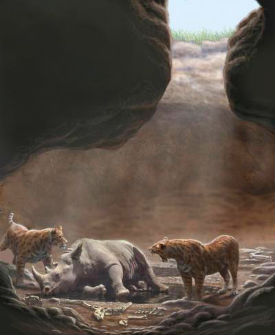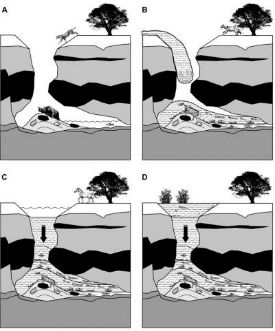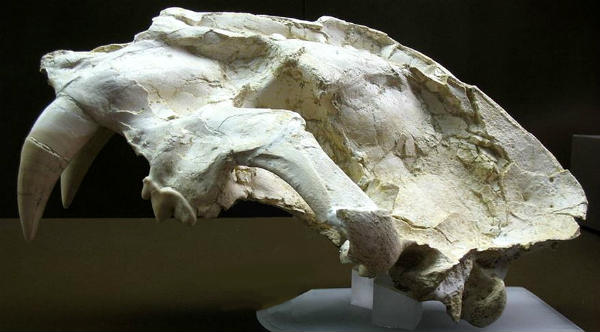Saber-toothed tiger trap
Spanish cave rich in carnivores
|
|
 Artist's reconstruction of Batallones-1 trap, showing two saber-toothed tigers Machairodus aphanistus feeding on the carcass of a rhinoceros. Artist: Mauricio Antón
Artist's reconstruction of Batallones-1 trap, showing two saber-toothed tigers Machairodus aphanistus feeding on the carcass of a rhinoceros. Artist: Mauricio Antón A reconstruction of the events leading to the accumulation of fossil bones in Batallones-1. A) Carnivores intentionally enter into the cave. B) Episodic floods filled the cavity and buried remains in different articulation stages; repeated carnivore entrances over time. C) Final stages of chamber filling (the location is no longer carnivore trap). D) Deposition of elements from the upper level assemblage of Batallones-1 in an uncertain taphonomic context (entrapment of herbivores?). Art by Mauricio Antón, Israel M. Sánchez and M. Soledad Domingo.
A reconstruction of the events leading to the accumulation of fossil bones in Batallones-1. A) Carnivores intentionally enter into the cave. B) Episodic floods filled the cavity and buried remains in different articulation stages; repeated carnivore entrances over time. C) Final stages of chamber filling (the location is no longer carnivore trap). D) Deposition of elements from the upper level assemblage of Batallones-1 in an uncertain taphonomic context (entrapment of herbivores?). Art by Mauricio Antón, Israel M. Sánchez and M. Soledad Domingo.
In a cave near Madrid researchers have found thousands of carnivore specimens, including those of the extinct saber-toothed tiger Machairodus aphanistus, the amphicyonid bear-dog Mageridcyon anceps, and the early hyena Protictitherium crassum. The site, known as Batallones-1, has also yielded ancestors of the extant red panda (Ailurus fulgens) and several other types of carnivores. All died under mysterious circumstances, about 10 million years ago. Fossil bones at this site are extremely well preserved because because they were deposited in the protective environment of the cave chamber.
It now appears these animals may have entered the cave intentionally and been trapped there, according to research just published in the journal PLOS ONE (Domingo et al. PLoS ONE 8(5): e63046). Different reasons have been offered to explain the unusually large concentration of healthy adult carnivores in this cave. These include mass mortality, accidental falls into the cave, or simply that the animals died in other locations and were carried by water into the cave. However, none of these explanations account for the absence of herbivores (nearly 98% of the macrofossils are of carnivores), or for the large number of apparently healthy adults.
In the present study, authors examined the geological conditions under which the cave was formed, the age of individuals in the cave and the time frame over which they likely entered this pit. Researchers tracked clues like the demography of the individuals recovered, the orientation of the remains and scarcity of fractured bones or trampling marks. They concluded that the animals most likely entered the cavity in search of food or water over a protracted period of time and were subsequently unable to make their way out, ultimately dying in the cave. The researchers suggest the scarcity of herbivore remains may indicate the precipitous entrance was clearly visible and thus avoided by these animals. However, the slope into this natural trap may not have been so steep that a carnivore, smelling water or food within, would not try to enter. Deeper in, the sides of the hole were probably steeper, so that some animals fell in. The fall wasn't long enough to kill, but the shape of the cave would have made it impossible to climb out.
Saber-toothed tiger
A saber-toothed tiger (also sabre-toothed cat), is an extinct type of predatory mammal quite similar to modern lions and tigers, but having much longer, curved, sword-like upper (maxillary) canine teeth. Various genera of saber-toothed tigers were found worldwide for some 42 million years. first appearing in the Eocene (42 mya) they went extict at the end of the Pleistocene epoch (~11,000 years ago). So it's likely that they were killed off by humans.
Based on materials obtained from the AAAS
